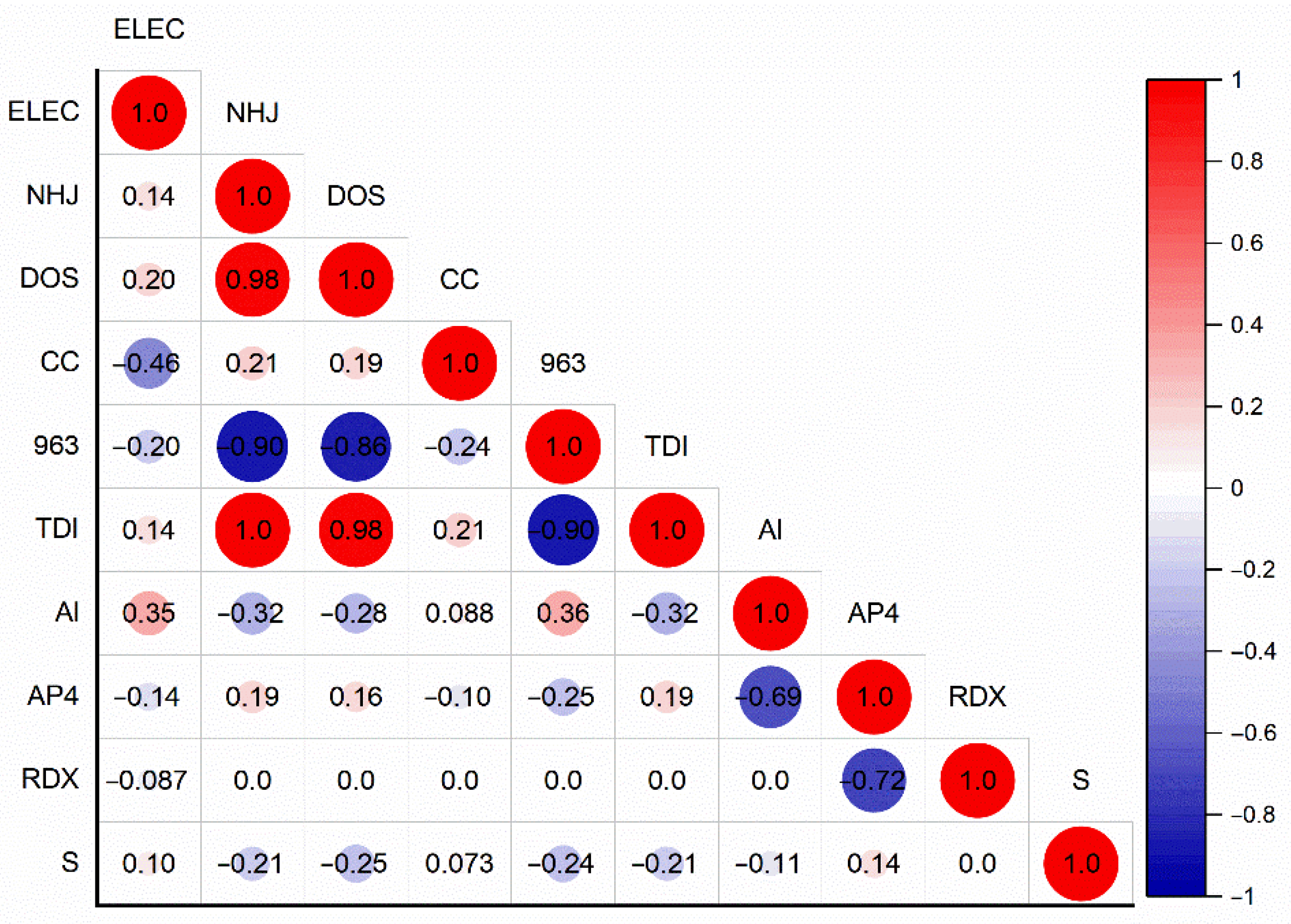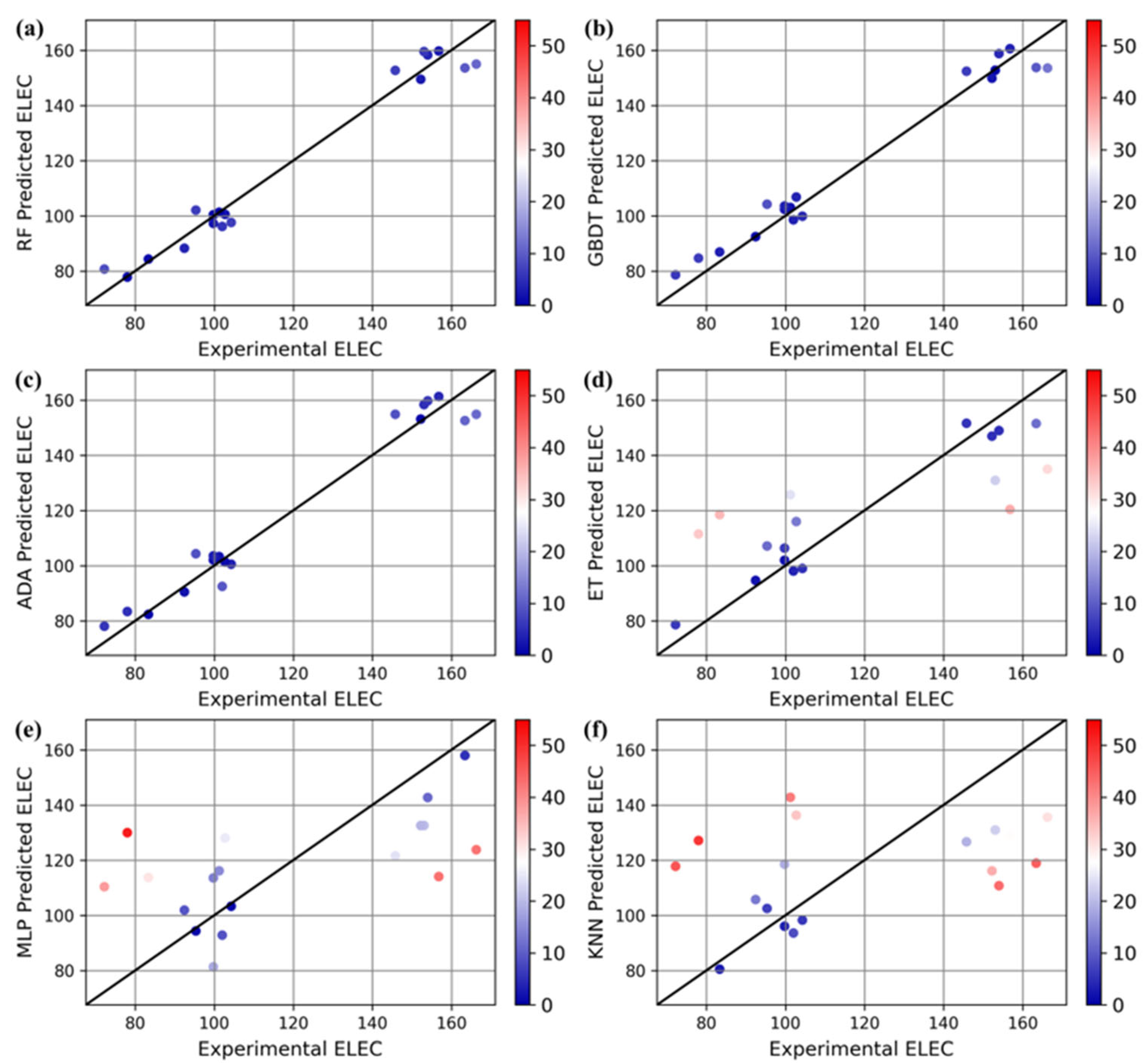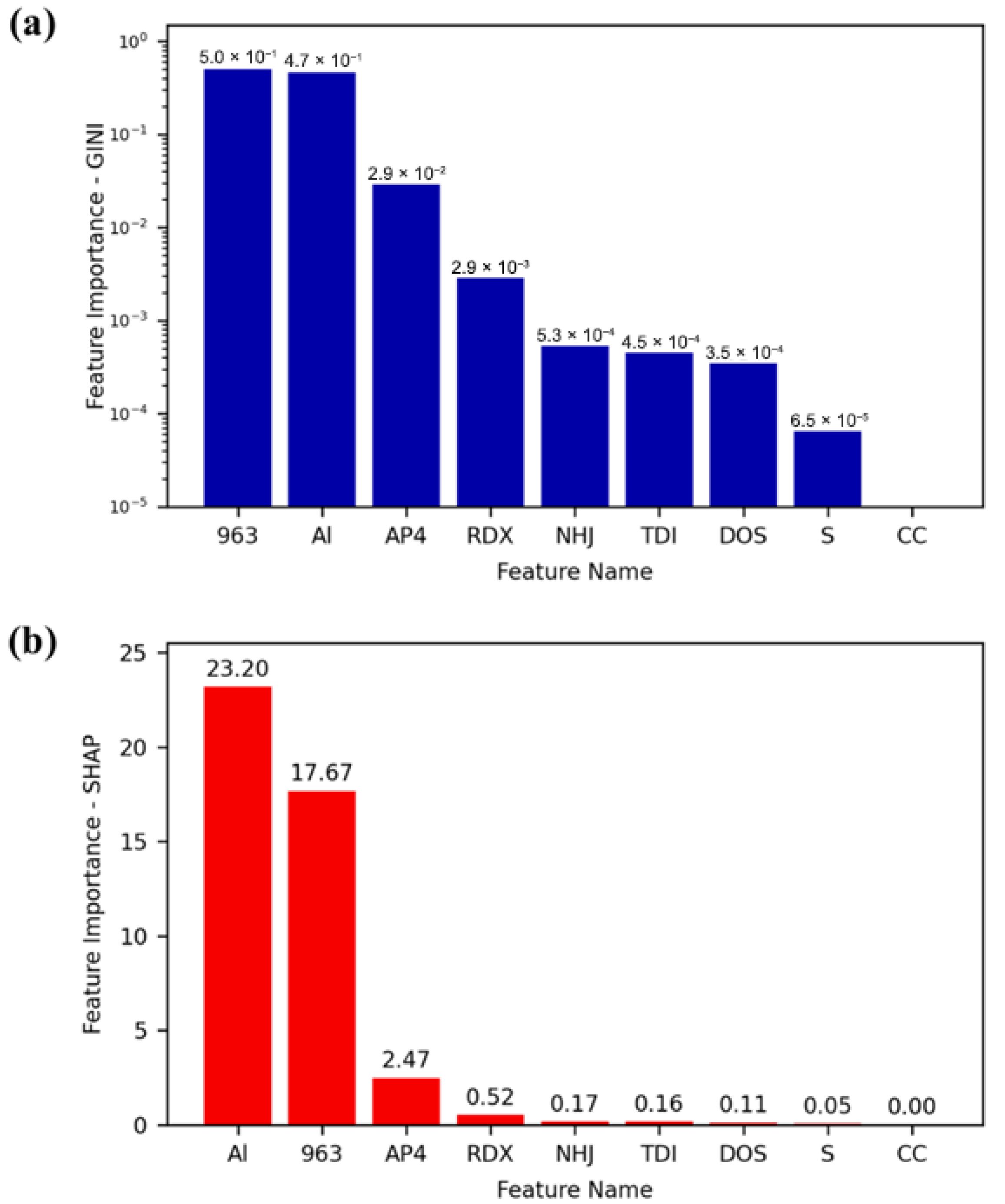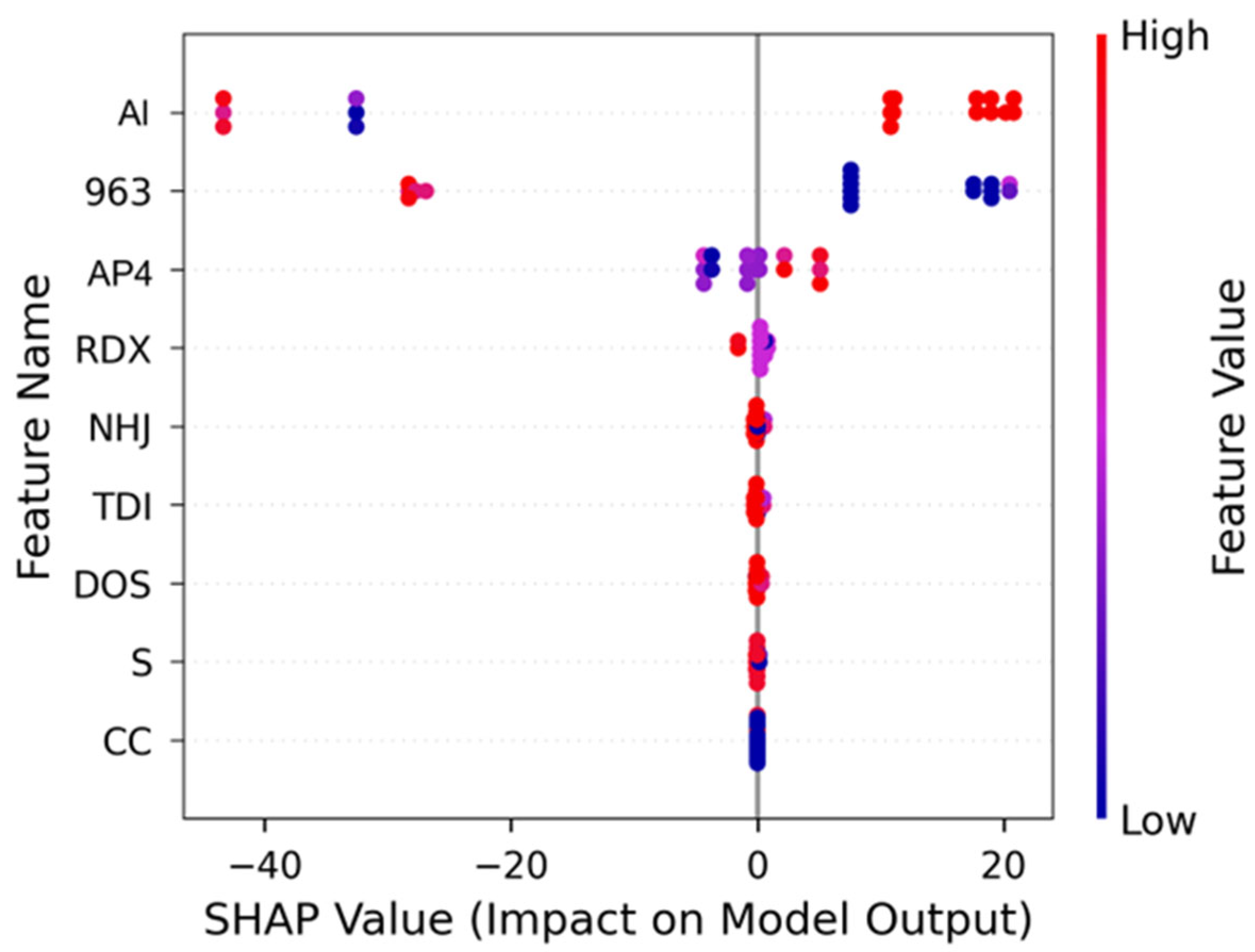Prediction of Propellant Electrostatic Sensitivity Based on Small-Sample Machine Learning Models
Abstract
1. Introduction
2. Materials and Methods
2.1. Preparation of Propellant Samples and Measurement of Static Inductance
2.2. Model Selection and Evaluation
2.3. Feature Correlation Ranking of the Model
2.4. Modeling Method
3. Results and Discussion
3.1. Data Set Characteristics
3.2. Model Prediction Accuracy
3.3. Model Interpretation
4. Conclusions
Supplementary Materials
Author Contributions
Funding
Data Availability Statement
Conflicts of Interest
References
- Jia, Y.; Wu, S.; Yao, N.; Zhou, C.; Zhang, T. Influence Mechanism of AP Gradation and Content on Interface Restriction of HTPB Solid Propellants. J. Solid Rocket Technol. 2023, 46, 886–892. (In Chinese) [Google Scholar]
- Liang, Y.; Ren, Q.; He, G.; Gao, J.; Wang, X. Viscoelastic Mechanical Response Analysis of HTPB Propellant Based on Fractional-Order Three-Parameter Model. J. Solid Rocket Technol. 2024, 47, 173–180. (In Chinese) [Google Scholar]
- Robinson, A.M.; Ka, D.; Zheng, X.; Xia, Y. Perfluoroalkyl-Functionalized HTPB Improves the Mechanical and Combustion Performance of Boron/HTPB Composites as Solid Fuel. ACS Appl. Polym. Mater. 2024, 6, 12654–12660. [Google Scholar] [CrossRef]
- Guo, X.D.; Liang, J.Y.; Li, F.S. Safety Property of FOX-7 and HTPB Propellants with FOX-7. Chin. J. Energ. Mater. 2010, 18, 316–319. (In Chinese) [Google Scholar]
- Sun, M.; Wang, Y.; Luo, T.; Rao, Y.; Zhang, T. Analysis and Optimization of Mathematical Statistics Methods for Electrostatic Sensitivity Test of Explosives. Chin. J. Explos. Propellants 2023, 46, 266–274. (In Chinese) [Google Scholar]
- He, Z.; Xia, Z.; Hu, J.; Li, Y. Effect of Aluminum Powder on Sensitivity of Perchlorate-Based Electrical Controlling Solid Propellant. Chin. J. Energ. Mater. 2020, 28, 52–55. (In Chinese) [Google Scholar]
- Chen, S.; Liu, Y.; Yao, W. Effect of Components on Combustion and Mechanical Properties of HTPB Propellant with High Energy. Chin. J. Explos. Propellants 2007, 30, 62–65. (In Chinese) [Google Scholar]
- Xu, H.; Zhao, F.; Pang, W.; Li, Y.; Yang, J. Properties of High Burning Rate HTPB Propellant Containing FOX-12. J. Solid Rocket Technol. 2011, 34, 745–749. (In Chinese) [Google Scholar]
- Wang, D.; He, G.; Wang, Z.; Zheng, K. Study on Acceleration-Based Combustion for Low-Burning Rate HTPB Propellant. J. Solid Rocket Technol. 2010, 33, 656–659. (In Chinese) [Google Scholar]
- Zeng, L.; Huimin, L.; Zhongqi, W.; Zhang, Q. Explosion Hazard of AP/HTPB in Fire Condition. Combust. Sci. Technol. 2023, 195, 1169–1183. [Google Scholar] [CrossRef]
- Sun, N.; Lin, K.; Shen, J.; Wang, X.; Zhang, B. A Machine Learning Fusion Model for Burning Rate Prediction of HTPB Propellant. J. Solid Rocket Technol. 2024, 47, 738–744. (In Chinese) [Google Scholar]
- Guo, Y.; Wu, Y.; Xu, S.; Pu, X.; Zhao, F. Accurate Prediction of the Comprehensive Properties for CMDB Propellants Based on Multi-Task Learning. Chem. Res. Appl. 2024, 36, 608–615. (In Chinese) [Google Scholar]
- Leem, J.; Jiang, Y.; Robinson, A.; Xia, Y.; Zheng, X. Data-Driven Approach to Tailoring Mechanical Properties of a Soft Material. Adv. Funct. Mater. 2023, 33, 2304451. [Google Scholar] [CrossRef]
- Cheng, Y.; Wang, C.; Zhang, K.; Yu, B.; Wang, Z. Mechanical Properties Prediction of HTPB Propellantsbased on Machine Learning Method. J. Solid Rocket Technol. 2024, 47, 54–59. (In Chinese) [Google Scholar]
- Guo, Y.; Wu, Y.; Liu, R.; Zhao, Q.; Xu, S. Machine-Learning Prediction for Safety of RDX-CMDB Propellants. J. Sichuan Univ. Nat. Sci. 2025, 62, 228–236. (In Chinese) [Google Scholar] [CrossRef]
- Klinger, D.; Casey, A.; Manship, T.; Son, S.; Strachan, A. Prediction of Solid Propellant Burning Rate Characteristics Using Machine Learning Techniques. Propellants Explos. Pyrotech. 2023, 48, e202200267. [Google Scholar] [CrossRef]
- Wang, R.; Li, Y.; Pan, L.; Fan, M.; Wang, Y. Machine Learning-Driven Discovery of High-Performance Solid Propellants. ACS Appl. Energy Mater. 2025, 8, 6756–6767. [Google Scholar] [CrossRef]
- QJ 20019.5-2018; Test Methods for Safety Performance of Composite Solid Propellants—Part 5 Electrostatic Spark Sensitivity. China Aerospace Standardization Institute: Beijing, China, 2018.
- Rigatti, S.J. Random Forest. J. Insur. Med. 2017, 47, 31–39. [Google Scholar] [CrossRef]
- Ke, G.; Xu, Z.; Zhang, J.; Bian, J.; Liu, T.-Y. DeepGBM: A Deep Learning Framework Distilled by GBDT for Online Prediction Tasks. In Proceedings of the 25th ACM SIGKDD International Conference on Knowledge Discovery & Data Mining, Association for Computing Machinery, Anchorage, AK, USA, 4–8 August 2019; pp. 384–394. [Google Scholar] [CrossRef]
- Schapire, R.E. Explaining AdaBoost. In Empirical Inference: Festschrift in Honor of Vladimir; Vapnik, N., Schölkopf, B., Luo, Z., Vovk, V., Eds.; Springer: Berlin/Heidelberg, Germany, 2013; pp. 37–52. [Google Scholar] [CrossRef]
- Baby, D.; Devaraj, S.J.; Hemanth, J.; Raj, A. Leukocyte Classification Based on Feature Selection Using Extra Trees Classifier: A Transfer Learning Approach. Turkish J. Electr. Eng. Comput. Sci. 2021, 29, 2742–2757. [Google Scholar] [CrossRef]
- Popescu, M.-C.; Balas, V.E.; Perescu-Popescu, L.; Mastorakis, N. Multilayer Perceptron and Neural Networks. WSEAS Trans. Circuits Syst. 2009, 8, 579–588. Available online: https://dl.acm.org/doi/10.5555/1639537.1639542 (accessed on 6 July 2025).
- Daniel, T.L.; Chantal, D.L. k-Nearest Neighbor Algorithm. In Discovering Knowledge in Data: An Introduction to Data Mining; Wiley Press: New York, NY, USA, 2014; pp. 149–164. [Google Scholar] [CrossRef]
- Li, K.; Wang, J.; Song, Y.; Wang, Y. Machine Learning-Guided Discovery of Ionic Polymer Electrolytes for Lithium Metal Batteries. Nat. Commun. 2023, 14, 2789. [Google Scholar] [CrossRef] [PubMed]
- Lei, Y.-J.; Lu, X.; Yoshikawa, H.; Matsumura, D.; Fan, Y.; Zhao, L.; Li, J.; Wang, S.; Gu, Q.; Liu, H.-K.; et al. Understanding the Charge Transfer Effects of Single Atoms for Boosting the Performance of Na-S Batteries. Nat. Commun. 2024, 15, 3325. [Google Scholar] [CrossRef] [PubMed]
- Cui, K.; Wang, T.; Zhang, Q.; Zhang, H. Multi-Functional Descriptor Design of V-Based Double Atomic Catalysts for Room Temperature Sodium-Sulfur Batteries. Small 2025, 21, 2409866. [Google Scholar] [CrossRef]
- Wan, Y.; Liu, Y.; Chao, D.; Li, W.; Zhao, D. Recent Advances in Hard Carbon Anodes with High Initial Coulombic Efficiency for Sodium-Ion Batteries. Nano Mater. Sci. 2023, 5, 189–201. [Google Scholar] [CrossRef]
- Van den Broeck, G.; Lykov, A.; Schleich, M.; Suciu, D. On the Tractability of SHAP Explanations. J. Artif. Int. Res. 2022, 74, 36. [Google Scholar] [CrossRef]
- Han, Z.; Chen, A.; Li, Z.; Zhang, M.; Wang, Z.; Yang, L.; Gao, R.; Jia, Y.; Ji, G.; Lao, Z.; et al. Machine Learning-Based Design of Electrocatalytic Materials towards High-Energy Lithium||Sulfur Batteries Development. Nat. Commun. 2024, 15, 8433. [Google Scholar] [CrossRef]
- Han, Z.; Tao, S.; Jia, Y.; Zhang, M.; Ma, R.; Xiao, X.; Zhou, J.; Gao, R.; Cui, K.; Wang, T.; et al. Data-Driven Insight into the Universal Structure-Property Relationship of Catalysts in Lithium-Sulfur Batteries. J. Am. Chem. Soc. 2025, 147, 26. [Google Scholar] [CrossRef]
- Takefuji, Y. Beyond XGBoost and SHAP: Unveiling True Feature Importance. J. Hazard. Mater. 2025, 488, 137382. [Google Scholar] [CrossRef]
- Lamens, A.; Bajorath, J. Comparing Explanations of Molecular Machine Learning Models Generated with Different Methods for the Calculation of Shapley Values. Mol. Inform. 2025, 44, e202500067. [Google Scholar] [CrossRef]
- Menze, B.H.; Kelm, B.M.; Masuch, R.; Himmelreich, U.; Bachert, P.; Petrich, W. A Comparison of Random Forest and its Gini Importance with Standard Chemometric Methods for the Feature Selection and Classification of Spectral Data. BMC Bioinform. 2009, 10, 213. [Google Scholar] [CrossRef]





| Ingredient | Abbreviation |
|---|---|
| HTPB adhesive | NHJ |
| Plasticizer | DOS |
| Catalyst | CC |
| 963 | |
| Curing agent | TDI |
| Aluminum powder | Al |
| RDX | RDX |
| Solid content | S |
| Ammonium perchlorate 40–60 mesh | AP4 |
| Model | Hyperparameters | Hyperparameter Space | Best Hyperparameters |
|---|---|---|---|
| RF | max_depth | 3, 4, 5 | 4 |
| min_samples_leaf | 1, 2 | 2 | |
| min_samples_split | 2, 3 | 2 | |
| n_estimators | 50, 100, 200 | 100 | |
| bootstrap | True, False | FALSE | |
| GBDT | learning_rate | uniform (0.01, 0.3) | 0.108 |
| max_depth | 3, 4, 5 | 4 | |
| min_samples_split | 2, 3, 4 | 4 | |
| n_estimators | 50, 100, 200 | 50 | |
| subsample | uniform (0.5, 0.4) | 0.8845 | |
| ADA | learning_rate | uniform (0.01, 0.3) | 0.1952 |
| n_estimators | 50, 100, 200 | 100 | |
| ET | bootstrap | True, False | FALSE |
| max_depth | 3, 4, 5 | 5 | |
| min_samples_leaf | 1, 2 | 1 | |
| min_samples_split | 2, 3 | 2 | |
| n_estimators | 50, 100, 200 | 200 | |
| MLP | activation | relu, tanh, logistic | relu |
| hidden_layer_sizes | 50, 100 | 100 | |
| learning_rate | constant, adaptive | constant | |
| solver | adam, sgd | adam | |
| alpha | loguniform (1 × 10−7, 1 × 10−2) | 9.6439 × 10−5 | |
| KNN | algorithm | auto, ball_tree, kd_tree, brute | brute |
| n_neighbors | 3, 5, 7 | 3 | |
| weights | uniform, distance | distance |
| RF | GBDT | ADA | ET | MLP | KNN | |
|---|---|---|---|---|---|---|
| R2 | 0.9681 | 0.9673 | 0.9618 | 0.6438 | 0.3446 | 0.1257 |
| MAE | 4.61 | 4.76 | 5.19 | 14.60 | 21.12 | 25.22 |
| RMSE | 5.66 | 5.73 | 6.19 | 18.90 | 25.64 | 29.62 |
| MAPE | 3.92% | 4.22% | 4.46% | 13.22% | 19.74% | 0.22% |
| MRes | 11.36 | 12.79 | 11.49 | 36.46 | 51.94 | 49.09 |
Disclaimer/Publisher’s Note: The statements, opinions and data contained in all publications are solely those of the individual author(s) and contributor(s) and not of MDPI and/or the editor(s). MDPI and/or the editor(s) disclaim responsibility for any injury to people or property resulting from any ideas, methods, instructions or products referred to in the content. |
© 2025 by the authors. Licensee MDPI, Basel, Switzerland. This article is an open access article distributed under the terms and conditions of the Creative Commons Attribution (CC BY) license (https://creativecommons.org/licenses/by/4.0/).
Share and Cite
Wang, F.; Cui, K.; Liu, J.; He, W.; Zhang, Q.; Zhang, W.; Wang, T. Prediction of Propellant Electrostatic Sensitivity Based on Small-Sample Machine Learning Models. Aerospace 2025, 12, 622. https://doi.org/10.3390/aerospace12070622
Wang F, Cui K, Liu J, He W, Zhang Q, Zhang W, Wang T. Prediction of Propellant Electrostatic Sensitivity Based on Small-Sample Machine Learning Models. Aerospace. 2025; 12(7):622. https://doi.org/10.3390/aerospace12070622
Chicago/Turabian StyleWang, Fei, Kai Cui, Jinxiang Liu, Wenhai He, Qiuyu Zhang, Weihai Zhang, and Tianshuai Wang. 2025. "Prediction of Propellant Electrostatic Sensitivity Based on Small-Sample Machine Learning Models" Aerospace 12, no. 7: 622. https://doi.org/10.3390/aerospace12070622
APA StyleWang, F., Cui, K., Liu, J., He, W., Zhang, Q., Zhang, W., & Wang, T. (2025). Prediction of Propellant Electrostatic Sensitivity Based on Small-Sample Machine Learning Models. Aerospace, 12(7), 622. https://doi.org/10.3390/aerospace12070622







